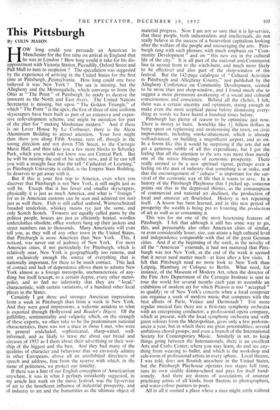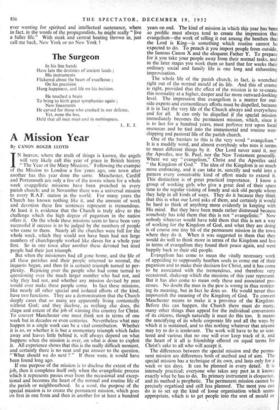This Pittsburgh
By COLIN MASON
HOW long could you persuade an American in Manchester for the first time on arrival in England that he was in London ? How long would it take for his dis- appointment with Victoria Station, Piccadilly, Oxford Street and Pall Mall to turn to suspicion ? The speculation was suggested by the experience of arriving in the United States for the first time at Pittsburgh, ,Pennsylvania. How long could one have believed it was New York ? The sea is missing, but the Allegheny and the Monongahela, which converge to form the Ohio at " The Point " of Pittsburgh, lie ready to deceive the innocent as the North and East rivers. The United Nations Secretariat is missing, but upon " The Golden Triangle," of which " The Point " is the apex, the first of three of nine uniform skyscrapers have been built as part of an extensive and expen- sive redevelopment scheme, and might be mistaken for part of the plan for " making Manhattan modern." And if there is no Lever House by Le Corbusier, there is the Alcoa Aluminium Building to attract attention. Your host might then show you along Fifth Avenue, turn off, though in the wrong direction and not down 57th Street, to the Carnegie Music Hall, and then take you a few more blocks to Schenley Park, which you would not know was not Central Park. But he will be nearing the end of his tether now, and if he can tell you with a straight face that the tall " Cathedral of Learning," as Pittsburgh University is called, is the Empire State Building, he deserves to get away with it.
But if this is your first trip to America, even when you discover that Pittsburgh is not New York, it still might just as well be. Except that it has fewer and smaller skyscrapers, physically it is just as much America, and what is ' foreign " for us in American customs can be seen and admired (or not) just as well there. Fish is still called seafood, Wienerschnitzel breaded tenderloin, whiskey means rye just the same, and only Scotch Scotch. Trousers are equally called pants by the politest people, houses are just as efficiently heated, woollen underclothes obsolete, office workers hang up their jackets and street numbers run to thousands. Many Americans will even tell you, as they will of any other town in the United 6tates, that Pittsburgh is more. American than New York. This, I noticed, was never out of jealousy of New York. For most American cities, if not particularly for Pittsburgh, which is relatively near, New York is geographically too remote, and not exclusively enough the source of everything that is nationally important, for there to be much contact. This lack of contact and lack of dependence allows them to admire New York almost as a foreign metropolis, uncharacteristic of any- thing but, itself (except, to a certain degree, every other metro- polis), and to feel no inferiority that they are " local," characteristic, with certain variations, of a hundred other local places in the States. Certainly I got thore and stronger American impressions from a week in Pittsburgh than from a week in New York.
And they were good impressions, a welcome antidote to what is exported through Hollywood and Reader's Digest. Of the gullibility, sentimentality and vulgarity which, on the strength of these exports, we often take to be the predominant national characteristics, there was not a trace in those I met, who were in general undeluded, sophisticated, sharp-witted, well- informed, and as likely to tease me about our bread and circuses of 1953 as I them about their advertising or their wor- ship of the biggest and the best. And they had many of the qualities of character and behaviour that we enviously admire in other Europeans, above all an uninhibited directness of speech and address, free from the reserve with which, in the name of politeness, we protect our timidity. If there was a hint of our English conception of Americanism anywhere, it was in what I perhaps mistakenly suggested, in my article last week on the music festival, was the lip-service of art to the beneficent influence of industrial prosperity, and of industry to art and the humanities as the ultimate object of material progress. Now I am not so sure that it is lip-servici, that these people, both industrialists and intellectuals, do not really believe in the success of a benevolent capitalism looking after the welfare of the people and encouraging the arts. Pitts- burgh rang with such phrases, with much emphasis on " Com- munity Development " and on " this new era in the cultural life of the city." It is all part of the national anti-Communist line (a second front to the witch-hunt, and much more likely to be effective) and also part of the shop-window of the festival. But the 142-page catalogue of " Cultural Activities in Pittsburgh and Allegheny County," just published by the Allegheny Conference on Community Development, seemed to be more than just shop-window, and I found much else to suggest a more permanent awakening of a social and cultural consciousness and conscience. Behind all the cliches, I felt, there was a certain sincerity and optimism, strong enough to make even the most sceptical pause before dismissing every- thing as words we have heard a hundred times before.
Pittsburgh has plenty of reason to be optimistic just now. There is money to bum. Somelike like 11 billion dollars is being spent on replanning and modernising the town, on civic improvement, including smoke-abatement, which is already well-advanced, on building a magnificent airport, and so on. In a boom like this it would be surprising if the arts did not get a generous nibble of all this expenditure, but I got the feeling that all the attention to the arts was more than merely one of the minor blessings of economic prosperity. There really seemed to be a new spiritual vigour, perhaps even a feeling on the part of industry that something is at stake, and that the encouragement of " culture " is important for the sur- vival of the economic way of life that it wants to save. In a history of the Pittsburgh Playhouse that I picked up, someone points out that in the depressed thirties, as the consumption of commercial and national art declined, the production of local and amateur art flourished. History is not repeating itself. )A lesson has been learned, and in this new period of prosperity the wealth is being put to fostering the production of art as well as to consuming it.
This was for me one of the most heartening features of Pittsburgh. I felt that although it still has some way to go, this, and presumably also other American cities of similar, or even considerably lesser, size, can attain a high cultural level and independence comparable with that of the great German cities. And if at the beginning of the week, in the novelty of all the " American " externals, it had not mattered that Pitts- burgh was not New York; at the end of the week it seemed that it never need matter much—at least after a few visits. I felt that Pittsburgh need no more look to New York than Leipzig, Hamburg or Cologne to Berlin. What need, for instance, of the Museum of Modern Art, when the director of the Fine Arts Department of the Carnegie Institute is sent to tour the world for several months each year to assemble an exhibition of modern art for which Picasso is too " accepted " to qualify; or of New York's concerts when a local composer can organise a week of modern music that compares with the best efforts of Paris, Venice and Darmstadt ? For more regular musical fare there are a first-rate symphony orchestra with an enterprising conductor; a professional opera company, which at present, with the local symphony orchestra and with guest soloists from the Metropolitan, gives only a few perform- ances a year, but in which there are great potentialities; several ambitious choral groups; and even a branch of the International Society for Contemporary Music. Similatly in art, to keep things going between the Internationals, there is an excellent Arts and Crafts Center, where you may learn, do and see any- thing from weaving to ballet, and which is the workshop and sale-room of professional artists in every sphere. Local theatre, I was told, does not flourish anywhere in the United States, but the Pittsburgh Playhouse operates two stages full time, runs its own sizable drama-school and pays for itself hand- somely. And there are dozens of associations of amateur practising artists of all kinds, from flautists to photographers, and water-colour painters to poets.
All in all it seemed a place where a man might settle without ever wanting for spiritual and intellectual sustenance, where in fact, in the words of the propagandists, he might really " live a fuller life." With steak and central heating thrown in, just call me back, New York or no New York !



































 Previous page
Previous page